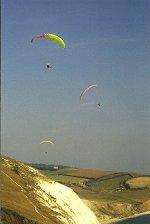IN THE AIR
PARAGLIDING & GLIDING
(SAILPLANE)
 PARAGLIDING PARAGLIDING
Paragliding began in the mid 1980's, and is the purest
form of free flight where you can get airborne in one day.
A Paraglider is launched from a hill or cliff, and
because it flies very slowly is simple to control, safe
to fly and one of the quickest forms of aviation to learn.
During your Intro' Day you will start with a video and
lecture on Paragliding. Following this you will be
allocated a canopy, harness and helmet for the day.
Around 12pm you will go to one of the nursery slopes
for some ground handling to learn how to inflate and
deflate the canopy for launching and landing.
Once your instructor is happy with this each student
will start a series of small flights from the base of the
hill, gradually working their way upwards during the
afternoon.
Depending on the weather you will finish any time
between 4pm and 6pm.
Frequently Asked Questions
I'm afraid of heights
Contrary to popular belief you are not jumping off cliffs
when you learn to paraglide. You actually start on flat
ground and learn to handle the canopy - which you inflate
above your head. To fly you then run forwards, and as the
canopy fills with air, lift up your legs and sit in soft
seat supported underneath - this will already be attached
to you by a harness. For your first flight you will only
be a foot or so off the ground, and as you gain
confidence you will progress further up the hill to take
a series of 'mini-flights'. Most people find they manage
to fly from the top of the hill to the bottom by the end
of the day - which is a massive 300 feet high!
What do I need to wear?
The most important things you need to wear are boots,
preferably with some ankle support - hiking boots are
great. Whilst you are learning you will fly from the hill
to its base and will have to walk back up, which means
you will get hot so wear layers that you can put on and
take off during the day and long trousers.
What about lunch?
Unless pre-organised you need to bring some lunch with
you and plenty of water as you will be doing a lot of
exercise during the day!
What happens if the weather is no good?
The weather conditions for paragliding need to be very
specific. Fortunately because we are an Island we have
flying sites for all wind directions and get a sea breeze
during the summer, which is ideal. However, we cannot
guarantee flying. For group bookings we will let you know
the night before if you will be flying the next day, and
if it is postponed we will already have discussed
alternative activities with you. If you have bought a
voucher for paragliding you need to call us the night
before, and if the school is not going out you can then
reschedule your day.
Is it safe?
Paragliding is an adventure sport on par with ski-ing,
which means you will get a huge adrenalin rush on you
first flight. However, it is strictly regulated by the
British Hang-Gliding and Paragliding Association (BHPA),
and you will be learning with a registered school who
must adhere to the BHPA's standards and have qualified
instructors. During all your flights you will have a
radio on you allowing you to hear instructions and
everyone can progress at their own pace. Whilst you learn
you will also be a registered student which covers you
for third party liability insurance.
MAIL
US HERE
with any questions and we will post them up here for you
to see our answer

GLIDING
The sensation of flight is often very strange at first,
but a view of the Earth from 2000 feet above the ground
soon overcomes these concerns as you look out for
familiar and not so familiar, landmarks.
On your flight from the Isle of Wight your glider will
be towed by a Piper Cub aircraft to a height of
approximately 2000 feet. Your instructor will fly this
part of the flight so you can fully enjoy the experience
and the views unfolding through your canopy. Once you
have reached 2000 feet your instructor will release your
glider from the tow plane and you will then be able to
enjoy the full experience of glider flying.
Frequently Asked Questions
Who can try Gliding?
People of all ages who are interested in experiencing the
joys of silent flight have a trial instructional flight,
on the Isle of Wight between March and October.
What happens during the session?
Before your flight you will be given an introductory talk
by a qualified gliding instructor who will explain how a
glider flies and what to expect from the flight. You will
fly in a two-seater glider which will be launched in the
air by a tow plane. Your instructor will then take you
flying over the hills, cliffs and beaches around the Isle
of Wight and show you how the glider is controlled. If
you wish you will be able to try your hand at flying the
glider on the day too!
How long will I be flying?
Your safety brief will last between 10 - 15 minutes, and
once you have been released from the tow plane you will
be gliding for around 20 minutes.
How many people can try it?
We have two gliders and two instructors available,
each taking one person. The tow plane takes one glider at
a time so each person will have a flight in turn.
|

